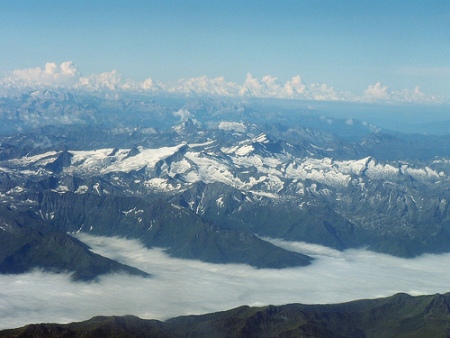

Julian Alps is a massive mountain range that extends to Slovenia. Julian Alps contain the highest peaks in the country including mount Triglav that reached an elevation of 2864 meters. It is named after Ancient Roman general and a statesman Julius Caesar. Most of the area is protected by Triglav National Park that protects large territory of valleys of Soča River as well as its tributaries. One of the most popular starting points to explore this terrain is by traveling to Bled Lake and nearby medieval Bled Castle.
They are built by Mesozoic marine sediments,
mostly 200 mil. years old Triassic and somewhat younger (180 mil.
years) Jurassic limestones and dolomites . Therefore, the walls are
steep and the tops and ridges are serrated. Limestone and dolomite
deposits are up to 2000 m thick. Strong alpid orogenesis before 30
mil. years caused the younger rock layers to sag over the older ones
. Many fossils tell us that there used to be a sea here . The
foundations are sloping south, so the southern slopes tend to be
less steep than the northern slopes.
The main massifs of the Julian Alps are constructed mainly of Wengen
funds and Dachtein limestone. Beautiful, parallel stacked stacks are
visible mainly on the Kanin floors and in the valley of the Triglav
Lakes , where numerous petrified shells, megalodonts are visible. On
the northern periphery are older rocks, that is, reddish or greenish
slate werfen stacks and rabble layers of dark gray limestone and
slate. Above the Soča and Bača valleys and in Bohinj, we can find
layers from the Jurassic period. In the surroundings of Tolmin and
Porezen there are Volcanic limestones from the younger Mesozoic .
Early Cretaceous limestones in the Soča Valley pass into the karst
world of the Dinaric Mountains .
The Soca valley is ending with limestone flysch rock: marl ,
sandstones and conglomerates of the Eocene . In the Ice Age that
ended 10,000 years ago, there were many glaciers in the Alps ,
including the Sava and Soča valleys. Glaciers sanded the mountain
slopes, creating valleys, building sills, applying boulders and
gravel, and pouring moraines into the valleys. In the Holocene and
alluvium , external weathering also caused chemical changes in the
surface, and running water caused mechanical changes.
Due to the operation of the Earth's internal forces that lifted the
Alps, many breaks occurred, breaking up the stone foundations.
Particularly striking is the Idrija Fault , which runs in the
northwest-southeast direction, forming the Idrijca Valley and the
middle part of the Soča River.
Ice Age
In the Pleistocene , which lasted 2 mil. years, the period of ice
ages began due to strong cooling . Ice caps were created in the
highlands , from which individual glaciers drifted towards the
valleys . The longest of them were Bohinj and Soča, the latter was
80 km long and reached Most na Soči . Extensive glaciers sanded the
ground with extreme weight, widening and deepening river valleys.
Thus, typical U-shaped glacial valleys were created . The glaciers
deposited much of the moraine material we have as evidence of the
length of the glacier. They will also be skale- huge bouldersfound
in all glacial valleys. The glaciers created the basins where
glacial lakes were created . In the valley are Lake Bled and Lake
Bohinj , and in the highlands are Kriška , Seven Lakes and Lake Krn
. Today, the Triglav Glacier is preserved in the Julian Alps , but
probably of younger origin, dating from the " small ice age "
between the 14th and 19th centuries . It has been significantly
reduced to date, although the surface has increased to approximately
2.5 ha due to slightly cooler temperatures and heavy snowfall over
the last 2 years .